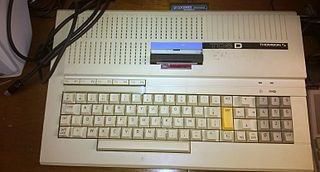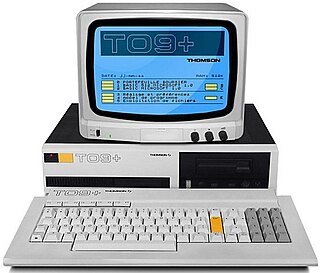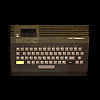Related Research Articles
In logic and computer science, the Boolean satisfiability problem (sometimes called propositional satisfiability problem and abbreviated SATISFIABILITY, SAT or B-SAT) is the problem of determining if there exists an interpretation that satisfies a given Boolean formula. In other words, it asks whether the variables of a given Boolean formula can be consistently replaced by the values TRUE or FALSE in such a way that the formula evaluates to TRUE. If this is the case, the formula is called satisfiable. On the other hand, if no such assignment exists, the function expressed by the formula is FALSE for all possible variable assignments and the formula is unsatisfiable. For example, the formula "a AND NOT b" is satisfiable because one can find the values a = TRUE and b = FALSE, which make (a AND NOT b) = TRUE. In contrast, "a AND NOT a" is unsatisfiable.

Yabasic is a free, open-source BASIC interpreter for Microsoft Windows and Unix platforms. Yabasic was originally developed by Marc-Oliver Ihm, who released the last stable version 2.77.3 in 2016. From version 2.77.1, the project has adopted the MIT License as well as the source code being moved to GitHub to encourage others to participate in its development.
In mathematics, a Diophantine equation is an equation of the form P(x1, ..., xj, y1, ..., yk) = 0 (usually abbreviated P(x, y) = 0) where P(x, y) is a polynomial with integer coefficients, where x1, ..., xj indicate parameters and y1, ..., yk indicate unknowns.

In computer graphics, a line drawing algorithm is an algorithm for approximating a line segment on discrete graphical media, such as pixel-based displays and printers. On such media, line drawing requires an approximation. Basic algorithms rasterize lines in one color. A better representation with multiple color gradations requires an advanced process, spatial anti-aliasing.
Integer BASIC is a BASIC interpreter written by Steve Wozniak for the Apple I and Apple II computers. Originally available on cassette for the Apple I in 1976, then included in ROM on the Apple II from its release in 1977, it was the first version of BASIC used by many early home computer owners.
In computer programming, the stride of an array is the number of locations in memory between beginnings of successive array elements, measured in bytes or in units of the size of the array's elements. The stride cannot be smaller than the element size but can be larger, indicating extra space between elements.

The ThomsonMO5 is a home computer introduced in France in June 1984 to compete against systems such as the ZX Spectrum and Commodore 64. It had a release price of 2390 FF.

The Thomson EF936x series is a type of Graphic Display Processor (GDP) by Thomson-EFCIS. The chip could draw at 1 million pixels per second, which was relatively advanced for the time of its release.
HP Time-Shared BASIC is a BASIC programming language interpreter for Hewlett-Packard's HP 2000 line of minicomputer-based time-sharing computer systems. TSB is historically notable as the platform that released the first public versions of the game Star Trek.

In computer graphics, line clipping is the process of removing (clipping) lines or portions of lines outside an area of interest. Typically, any part of a line which is outside of the viewing area is removed.
As one of the methods of structural analysis, the direct stiffness method, also known as the matrix stiffness method, is particularly suited for computer-automated analysis of complex structures including the statically indeterminate type. It is a matrix method that makes use of the members' stiffness relations for computing member forces and displacements in structures. The direct stiffness method is the most common implementation of the finite element method (FEM). In applying the method, the system must be modeled as a set of simpler, idealized elements interconnected at the nodes. The material stiffness properties of these elements are then, through matrix mathematics, compiled into a single matrix equation which governs the behaviour of the entire idealized structure. The structure’s unknown displacements and forces can then be determined by solving this equation. The direct stiffness method forms the basis for most commercial and free source finite element software.
Symbolic Link (SYLK) is a Microsoft file format typically used to exchange data between applications, specifically spreadsheets. SYLK files conventionally have a .slk suffix. Composed of only displayable ANSI characters, it can be easily created and processed by other applications, such as databases.
Color BASIC is the implementation of Microsoft BASIC that is included in the ROM of the Tandy/Radio Shack TRS-80 Color Computers manufactured between 1980 and 1991. BASIC is a high level language with simple syntax that makes it easy to write simple programs. Color BASIC is interpreted, that is, decoded as it is run.
In computer graphics, a digital differential analyzer (DDA) is hardware or software used for interpolation of variables over an interval between start and end point. DDAs are used for rasterization of lines, triangles and polygons. They can be extended to non linear functions, such as perspective correct texture mapping, quadratic curves, and traversing voxels.
In game theory, a strong Nash equilibrium(SNE) is a combination of actions of the different players, in which no coalition of players can cooperatively deviate in a way that strictly benefits all of its members, given that the actions of the other players remain fixed. This is in contrast to simple Nash equilibrium, which considers only deviations by individual players. The concept was introduced by Israel Aumann in 1959. SNE is particularly useful in areas such as the study of voting systems, in which there are typically many more players than possible outcomes, and so plain Nash equilibria are far too abundant.

The Thomson TO7, also called Thomson 9000 is a home computer introduced by Thomson SA in November 1982, with an original retail price of 3750 FF. By 1983 over 40000 units were produced. About 84 games were released for the TO7.

The ThomsonMO6 was a Motorola 6809E-based computer introduced in France in 1986. It was intended as the successor to the Thomson MO5 and featured 128 KB of RAM, a 40 × 25 text display, and a new built-in Microsoft BASIC interpreter. It retained compatibility with its predecessor, while incorporating the same technology as the TO8.

The Thomson TO8 is a home computer introduced by French company Thomson SA in 1986, with a cost of 2,990 FF. It replaces its predecessor, the Thomson TO7/70, while remaining essentially compatible.

The Thomson TO9+ is a home computer introduced by French company Thomson SA in 1986. It kept the professional look of the Thomson TO9 by using a separate keyboard.
The Computing for All plan was a French government plan to introduce computers to the country's 11 million pupils. A second goal was to support national industry. It followed several introductory computer science programs in schools since 1971. The IPT plan was presented to the press on January 25, 1985 by Laurent Fabius, Prime Minister at the time. It aimed to set up, from the start of that school year, more than 120,000 machines in 50,000 schools and to train 110,000 teachers. Its estimated cost was 1.8 billion francs, including 1.5 billion for equipment. The plan was abandoned in 1989.
References
- 1 2 "Thomson MO 5". www.old-computers.com. Retrieved 2022-11-28.
- 1 2 "Thomson TO 7". www.old-computers.com. Retrieved 2022-11-28.
- 1 2 3 "Thomson TO7". Obsolete Tears. 2018.
- 1 2 Roug, Søren. "Quick reference guide to BASIC 1.0". Roug Website. Retrieved 2022-11-28.
- ↑ "documentations:basic_howto". Demomaker's guide to Thomson computers. 2015.
- 1 2 Debart, Patrice (December 1986). "Bidouille du système Thomson TO7 - MO5 - TO9". Le Bulletin de l'EPI. No. 44.
- 1 2 3 "documentations:basic_keywords". Demomaker's guide to Thomson computers. 2015.
- ↑ Ina.fr, Institut National de l’Audiovisuel- (January 1985). "Plan informatique : conférence de presse Fabius". Ina.fr.
- 1 2 3 DELHAYE (1987). "DES PROCÉDURES UTILITAIRES EN BASIC POUR TO7 ET MO5" (PDF). Le Bulletin de l'EPI (48): 217.
- ↑ "THOMSON TO7/70". Ordinateur de collection. 2012. Retrieved 2022-11-28.
- ↑ Blondel (1982). Initiation au BASIC TO7/TO7-70. CEDIC.
- ↑ Wanner (1984). Aller plus loin em BASIC TO7. EYROLLES.
- ↑ Trost (1984). TO7 56 Programmes BASIC. Sybex.
- ↑ Monsaut (1984). Jeux en BASIC sur TO7. Sybex.
- ↑ Trost (1984). MO5 56 Programmes. Sybex.
- ↑ Fabio, Paolo (January 15, 2018). "Retrocomputing: How to install Thomson MO5, MO6, TO7, TO8, TO9 and Olivetti Prodest PC 128 emulator on Windows, Apple Mac, Linux and BSD". Paolo Fabio Zaino's Blog.
- ↑ Blondel (1985). Initiation au BASIC 128 TO7-70. CEDIC.
- ↑ Nabonne (1986). Interpreteur BASIC 1.0 des TO7-70 et TO9. EYROLLES.
- ↑ "Thomson TO 8 - TO 8D". www.old-computers.com. Retrieved 2022-11-28.
- ↑ "Thomson TO 9 plus". www.old-computers.com.
